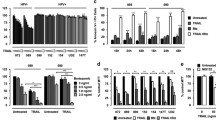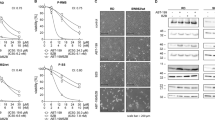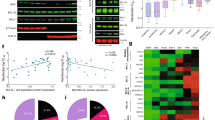Abstract
TNF-related apoptosis-inducing ligand (TRAIL), a promising novel anti-cancer cytokine of the TNF superfamily, and Bortezomib, the first-in-class clinically used proteasome inhibitor, alone or in combination have been shown to efficiently kill numerous tumor cell lines. However, data concerning primary human tumor cells are very rare. Using primary esthesioneuroblastoma cells we analyzed the anti-tumor potential and the mechanism employed by Bortezomib in combination with TRAIL for the treatment of this rare but aggressive tumor. Expression of components of the TRAIL pathway was analyzed in tumor specimens and isolated primary tumor cells at the protein level. Cells were treated with TRAIL, Bortezomib, and a combination thereof, and apoptosis induction was quantified. Clonogenicity assays were performed to elucidate the long-term effect of this treatment. Despite expressing all components of the TRAIL pathway, freshly isolated primary esthesioneuroblastoma cells were completely resistant to TRAIL-induced apoptosis. They could, however, be very efficiently sensitized by subtoxic doses of Bortezomib. The influence of Bortezomib on the TRAIL pathway was analyzed and showed upregulation of TRAIL death receptor expression, enhancement of the TRAIL death-inducing signaling complex (DISC), and downregulation of anti-apoptotic proteins of the TRAIL pathway. Of clinical relevance, TRAIL-resistant primary tumor cells could be repeatedly sensitized by Bortezomib, providing the basis for repeated clinical application schedules. This is the first report on the highly synergistic induction of apoptosis in primary esthesioneuroblastoma cells by Bortezomib and TRAIL. This combination, therefore, represents a promising novel therapeutic option for esthesioneuroblastoma.







Similar content being viewed by others
Abbreviations
- DISC:
-
Death inducing signaling complex
- FACS:
-
Fluorescence activated cell sorting
- FSC/SSC:
-
Forward scatter/side scatter
- HRP:
-
Horseradish peroxidase
- iz-TRAIL:
-
Isoleucine Zipper TRAIL
- MTT:
-
3-(4,5-Dimethylthiazol-2-yl)-2,5-diphenyltetrazolium bromide
- OPG:
-
Osteoprotegerin
- PE:
-
ß-Phycoerythrin
- PI:
-
Propidium iodide
- RSB:
-
Reducing sample buffer
- siRNA:
-
Short interfering RNA
- TRAIL:
-
TNF-related apoptosis-inducing ligand
References
Diaz EM Jr, Johnigan RH 3rd, Pero C, El-Naggar AK, Roberts DB, Barker JL, DeMonte F (2005) Olfactory neuroblastoma: the 22-year experience at one comprehensive cancer center. Head Neck 27:138–149
Bradley PJ, Jones NS, Robertson I (2003) Diagnosis and management of esthesioneuroblastoma. Curr Opin Otolaryngol Head Neck Surg 11:112–118
Zhang LW, Zhang MS, Qi J, Zhang JT, Li GL, Luo L, Wang ZC (2007) Management of intracranial invasive olfactory neuroblastoma. Chin Med J (Engl) 120:224–227
Mori R, Sakai H, Kato M, Hida T, Nakajima M, Fukuda T, Fukunaga M, Abe T (2007) Olfactory neuroblastoma with spinal metastasis: case report. No Shinkei Geka 35:503–508
Morita A, Ebersold MJ, Olsen KD, Foote RL, Lewis JE, Quast LM (1993) Esthesioneuroblastoma: prognosis and management. Neurosurgery 32:706–714 (discussion 714–715)
Bachar G, Goldstein DP, Shah M, Tandon A, Ringash J, Pond G, Gullane PJ, Perez-Ordonez B, Gilbert RW, Brown DH, Gentili F, O’Sullivan B, Irish JC (2008) Esthesioneuroblastoma: the Princess Margaret hospital experience. Head Neck 30:1607–1614
Dulguerov P, Allal AS, Calcaterra TC (2001) Esthesioneuroblastoma: a meta-analysis and review. Lancet Oncol 2:683–690
Porter AB, Bernold DM, Giannini C, Foote RL, Link MJ, Olsen KD, Moynihan TJ, Buckner JC (2008) Retrospective review of adjuvant chemotherapy for esthesioneuroblastoma. J Neurooncol 90:201–204
Walczak H, Krammer PH (2000) The CD95 (APO-1/Fas) and the TRAIL (APO-2L) apoptosis systems. Exp Cell Res 256:58–66
MacFarlane M (2003) TRAIL-induced signalling and apoptosis. Toxicol Lett 139:89–97
Wu GS (2009) TRAIL as a target in anti-cancer therapy. Cancer Lett
Bellail AC, Qi L, Mulligan P, Chhabra V, Hao C (2009) TRAIL agonists on clinical trials for cancer therapy: the promises and the challenges. Rev Recent Clin Trials 4:34–41
Koschny R, Walczak H, Ganten TM (2007) The promise of TRAIL-potential and risks of a novel anticancer therapy. J Mol Med 85:923–935
Fulda S, Wick W, Weller M, Debatin KM (2002) Smac agonists sensitize for Apo2L/TRAIL- or anticancer drug-induced apoptosis and induce regression of malignant glioma in vivo. Nat Med 8:808–815
Pollack IF, Erff M, Ashkenazi A (2001) Direct stimulation of apoptotic signaling by soluble apo2l/tumor necrosis factor-related apoptosis-inducing ligand leads to selective killing of glioma cells. Clin Cancer Res 7:1362–1369
Koschny R, Holland H, Sykora J, Haas TL, Sprick MR, Ganten TM, Krupp W, Bauer M, Ahnert P, Meixensberger J, Walczak H (2007) Bortezomib sensitizes primary human astrocytoma cells of WHO grades I to IV for tumor necrosis factor-related apoptosis-inducing ligand-induced apoptosis. Clin Cancer Res 13:3403–3412
Armstrong MB, Schumacher KR, Mody R, Yanik GA, Opipari AW Jr, Castle VP (2008) Bortezomib as a therapeutic candidate for neuroblastoma. J Exp Ther Oncol 7:135–145
Koschny R, Ganten TM, Sykora J, Haas TL, Sprick MR, Kolb A, Stremmel W, Walczak H (2007) TRAIL/bortezomib cotreatment is potentially hepatotoxic but induces cancer-specific apoptosis within a therapeutic window. Hepatology 45:649–658
Ganten TM, Koschny R, Haas TL, Sykora J, Li-Weber M, Herzer K, Walczak H (2005) Proteasome inhibition sensitizes hepatocellular carcinoma cells, but not human hepatocytes, to TRAIL. Hepatology 42:588–597
Holland H, Koschny R, Krupp W, Meixensberger J, Bauer M, Kirsten H, Ahnert P (2007) Comprehensive cytogenetic characterization of an esthesioneuroblastoma. Cancer Genet Cytogenet 173:89–96
Ganten TM, Koschny R, Sykora J, Schulze-Bergkamen H, Buchler P, Haas TL, Schader MB, Untergasser A, Stremmel W, Walczak H (2006) Preclinical differentiation between apparently safe and potentially hepatotoxic applications of TRAIL either alone or in combination with chemotherapeutic drugs. Clin Cancer Res 12:2640–2646
Ganten TM, Haas TL, Sykora J, Stahl H, Sprick MR, Fas SC, Krueger A, Weigand MA, Grosse-Wilde A, Stremmel W, Krammer PH, Walczak H (2004) Enhanced caspase-8 recruitment to and activation at the DISC is critical for sensitisation of human hepatocellular carcinoma cells to TRAIL-induced apoptosis by chemotherapeutic drugs. Cell Death Differ 11(Suppl 1):S86–S96
Sprick MR, Weigand MA, Rieser E, Rauch CT, Juo P, Blenis J, Krammer PH, Walczak H (2000) FADD/MORT1 and caspase-8 are recruited to TRAIL receptors 1 and 2 and are essential for apoptosis mediated by TRAIL receptor 2. Immunity 12:599–609
Strieder V, Lutz W (2002) Regulation of N-myc expression in development and disease. Cancer Lett 180:107–119
Castaneda VL, Cheah MS, Saldivar VA, Richmond CM, Parmley RT (1991) Cytogenetic and molecular evaluation of clinically aggressive esthesioneuroblastoma. Am J Pediatr Hematol Oncol 13:62–70
Xiao C, Yang BF, Asadi N, Beguinot F, Hao C (2002) Tumor necrosis factor-related apoptosis-inducing ligand-induced death- inducing signaling complex and its modulation by c-FLIP and PED/PEA-15 in glioma cells. J Biol Chem 277:25020–25025
Ashkenazi A, Herbst RS (2008) To kill a tumor cell: the potential of proapoptotic receptor agonists. J Clin Invest 118:1979–1990
Yang X, Merchant MS, Romero ME, Tsokos M, Wexler LH, Kontny U, Mackall CL, Thiele CJ (2003) Induction of caspase 8 by interferon gamma renders some neuroblastoma (NB) cells sensitive to tumor necrosis factor-related apoptosis-inducing ligand (TRAIL) but reveals that a lack of membrane TR1/TR2 also contributes to TRAIL resistance in NB. Cancer Res 63:1122–1129
Ashley DM, Riffkin CD, Muscat AM, Knight MJ, Kaye AH, Novak U, Hawkins CJ (2005) Caspase 8 is absent or low in many ex vivo gliomas. Cancer 104:1487–1496
Ishimura N, Isomoto H, Bronk SF, Gores GJ (2006) Trail induces cell migration and invasion in apoptosis-resistant cholangiocarcinoma cells. Am J Physiol Gastrointest Liver Physiol 290:G129–G136
Trauzold A, Siegmund D, Schniewind B, Sipos B, Egberts J, Zorenkov D, Emme D, Roder C, Kalthoff H, Wajant H (2006) TRAIL promotes metastasis of human pancreatic ductal adenocarcinoma. Oncogene 25:7434–7439
Johnson TR, Stone K, Nikrad M, Yeh T, Zong WX, Thompson CB, Nesterov A, Kraft AS (2003) The proteasome inhibitor PS-341 overcomes TRAIL resistance in Bax and caspase 9-negative or Bcl-xL overexpressing cells. Oncogene 22:4953–4963
Geserick P, Drewniok C, Hupe M, Haas TL, Diessenbacher P, Sprick MR, Schon MP, Henkler F, Gollnick H, Walczak H, Leverkus M (2008) Suppression of cFLIP is sufficient to sensitize human melanoma cells to TRAIL- and CD95L-mediated apoptosis. Oncogene 27:3211–3220
Hao C, Beguinot F, Condorelli G, Trencia A, Van Meir EG, Yong VW, Parney IF, Roa WH, Petruk KC (2001) Induction and intracellular regulation of tumor necrosis factor-related apoptosis-inducing ligand (TRAIL) mediated apotosis in human malignant glioma cells. Cancer Res 61:1162–1170
Kim JW, Kong IG, Lee CH, Kim DY, Rhee CS, Min YG, Kim CW, Chung JH (2008) Expression of Bcl-2 in olfactory neuroblastoma and its association with chemotherapy and survival. Otolaryngol Head Neck Surg 139:708–712
Acknowledgments
The authors like to thank Bärbel Moos, Jutta Mohr, and Rainer Baran-Schmidt for excellent technical assistance, and Tobias Paffhausen (Department of Tumour Genetics, German Cancer Research Center, Heidelberg) for the anti-N-myc antibody and control lysates. We like to thank Dr. Christian Hartmann (Institute of Neuropathology, University of Heidelberg) for providing paraffin-embedded tumor material of esthesioneuroblastoma patients 572/98 and 804/03 and Prof. Dr. Hartmut Arps (Hospital Fulda, Fulda) for providing paraffin-embedded tumor material of patient #2. Ronald Koschny was supported by the Deutsche Forschungsgemeinschaft (DFG). The work was funded by the Tumorzentrum HD/MA (T. M. Ganten und H. Walczak) and the Deutsche Krebshilfe (H. Walczak).
Author information
Authors and Affiliations
Corresponding author
Electronic supplementary material
Below is the link to the electronic supplementary material.
Rights and permissions
About this article
Cite this article
Koschny, R., Holland, H., Sykora, J. et al. Bortezomib sensitizes primary human esthesioneuroblastoma cells to TRAIL-induced apoptosis. J Neurooncol 97, 171–185 (2010). https://doi.org/10.1007/s11060-009-0010-6
Received:
Accepted:
Published:
Issue Date:
DOI: https://doi.org/10.1007/s11060-009-0010-6




